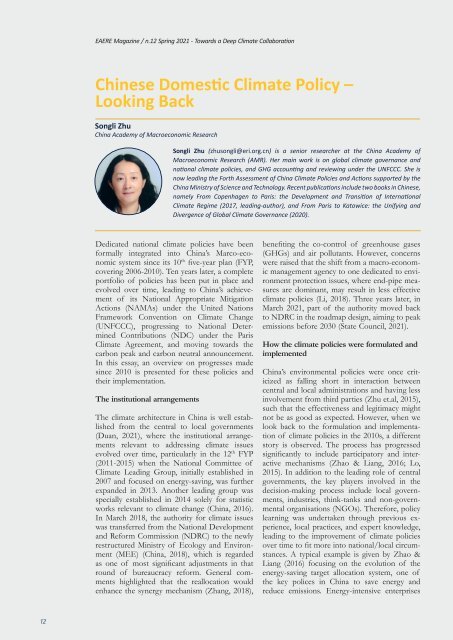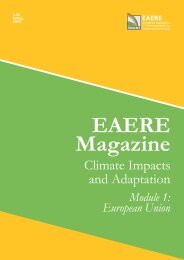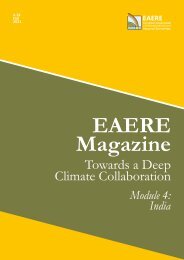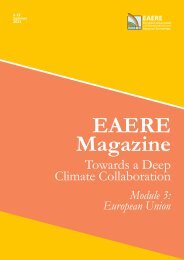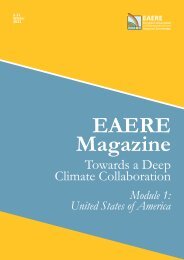You also want an ePaper? Increase the reach of your titles
YUMPU automatically turns print PDFs into web optimized ePapers that Google loves.
<strong>EAERE</strong> <strong>Magazine</strong> / n.12 <strong>Spring</strong> <strong>2021</strong> - Towards a Deep Climate Collaboration<br />
Chinese Domestic Climate Policy –<br />
Looking Back<br />
Songli Zhu<br />
China Academy of Macroeconomic Research<br />
Songli Zhu (zhusongli@eri.org.cn) is a senior researcher at the China Academy of<br />
Macroeconomic Research (AMR). Her main work is on global climate governance and<br />
national climate policies, and GHG accounting and reviewing under the UNFCCC. She is<br />
now leading the Forth Assessment of China Climate Policies and Actions supported by the<br />
China Ministry of Science and Technology. Recent publications include two books in Chinese,<br />
namely From Copenhagen to Paris: the Development and Transition of International<br />
Climate Regime (2017, leading-author), and From Paris to Katowice: the Unifying and<br />
Divergence of Global Climate Governance (2020).<br />
Dedicated national climate policies have been<br />
formally integrated into China’s Marco-economic<br />
system since its 10 th five-year plan (FYP,<br />
covering 2006-2010). Ten years later, a complete<br />
portfolio of policies has been put in place and<br />
evolved over time, leading to China’s achievement<br />
of its National Appropriate Mitigation<br />
Actions (NAMAs) under the United Nations<br />
Framework Convention on Climate Change<br />
(UNFCCC), progressing to National Determined<br />
Contributions (NDC) under the Paris<br />
Climate Agreement, and moving towards the<br />
carbon peak and carbon neutral announcement.<br />
In this essay, an overview on progresses made<br />
since 2010 is presented for these policies and<br />
their implementation.<br />
The institutional arrangements<br />
The climate architecture in China is well established<br />
from the central to local governments<br />
(Duan, <strong>2021</strong>), where the institutional arrangements<br />
relevant to addressing climate issues<br />
evolved over time, particularly in the 12 th FYP<br />
(2011-2015) when the National Committee of<br />
Climate Leading Group, initially established in<br />
2007 and focused on energy-saving, was further<br />
expanded in 2013. Another leading group was<br />
specially established in 2014 solely for statistic<br />
works relevant to climate change (China, 2016).<br />
In March 2018, the authority for climate issues<br />
was transferred from the National Development<br />
and Reform Commission (NDRC) to the newly<br />
restructured Ministry of Ecology and Environment<br />
(MEE) (China, 2018), which is regarded<br />
as one of most significant adjustments in that<br />
round of bureaucracy reform. General comments<br />
highlighted that the reallocation would<br />
enhance the synergy mechanism (Zhang, 2018),<br />
benefiting the co-control of greenhouse gases<br />
(GHGs) and air pollutants. However, concerns<br />
were raised that the shift from a macro-economic<br />
management agency to one dedicated to environment<br />
protection issues, where end-pipe measures<br />
are dominant, may result in less effective<br />
climate policies (Li, 2018). Three years later, in<br />
March <strong>2021</strong>, part of the authority moved back<br />
to NDRC in the roadmap design, aiming to peak<br />
emissions before 2030 (State Council, <strong>2021</strong>).<br />
How the climate policies were formulated and<br />
implemented<br />
China’s environmental policies were once criticized<br />
as falling short in interaction between<br />
central and local administrations and having less<br />
involvement from third parties (Zhu et.al, 2015),<br />
such that the effectiveness and legitimacy might<br />
not be as good as expected. However, when we<br />
look back to the formulation and implementation<br />
of climate policies in the 2010s, a different<br />
story is observed. The process has progressed<br />
significantly to include participatory and interactive<br />
mechanisms (Zhao & Liang, 2016; Lo,<br />
2015). In addition to the leading role of central<br />
governments, the key players involved in the<br />
decision-making process include local governments,<br />
industries, think-tanks and non-governmental<br />
organisations (NGOs). Therefore, policy<br />
learning was undertaken through previous experience,<br />
local practices, and expert knowledge,<br />
leading to the improvement of climate policies<br />
over time to fit more into national/local circumstances.<br />
A typical example is given by Zhao &<br />
Liang (2016) focusing on the evolution of the<br />
energy-saving target allocation system, one of<br />
the key polices in China to save energy and<br />
reduce emissions. Energy-intensive enterprises<br />
12


